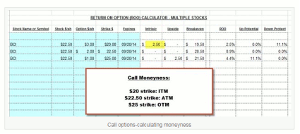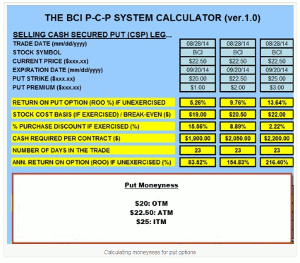Alan Ellman of TheBlueCollarInvestor.com explains how the “moneyness” of in-the-money and out-of-the-money strikes is inversely related for calls and puts and how each strike offers certain advantages that should be taken advantage of depending on certain conditions.
Strike price selection is such a key part of options trading basics and options calculations. There are 3 types of strike prices for both put and call options: in-the-money, at-the-money (and the closely related near-the-money), and out-of-the-money. Moneyness tells option holders whether exercising will lead to a profit. Moneyness looks at the value of an option if you were to exercise it right now. A loss would signify the option is out-of-the money, while a gain would mean it’s in-the-money. At-the-money means that you will break even upon exercise. In this article, I will show examples of the three types of strikes and the moneyness of each as they relate to put and call options.
Preview example
Let’s assume the price of a stock is $22.50. Here’s the easy part first: The $22.50 strike price would be at-the-money for both puts and calls. If the option holder (buyer) exercised the option and bought or sold the stock for $22.50, it would represent a breakeven situation compared to the current market value of $22.50.
Next, we will evaluate the $20 strike price. For call options, this strike price is in-the-money because if the call was exercised, the call buyer would then buy the shares at $20 and can sell those shares at market for $22.50, generating a profit of $2.50 per share. The amount that the strike price is in-the-money is known as intrinsic value. For put options, however, the $20 strike is out-of-the-money because the holder has the right to sell the shares for $20, below market value.
Looking at the $25 strike price, the call holder has the right to buy the shares for $25, well above market value and therefore with no inherent value. For call options, this strike is out-of-the-money. For put options, however, the $25 strike is in-the-money because the holder of the put has the right to sell his shares for $25, well above market value of $22.50. This option then has $2.50 of intrinsic value. The moneyness of in-the-money and out-of-the-money strikes is inversely related for calls and puts. A reliable way to determine the moneyness of an option is to ask this question: If I am the holder of the option, am I better off exercising the option or buying or selling the stock at market? If you are better off exercising then the strike price is in-the-money and has intrinsic value.
Example of calculating moneyness for call options using the Ellman Calculator
Each strike has its benefits:
- $20 ITM: Offers 11.1% protection of the initial option profit (ROO or 2.5%). I favor these in bear or volatile markets.
- $22.50 ATM: Offers the highest initial returns (ROO or 8.9%) but no upside potential or downside protection of the ROO.
- $25 OTM: Offers a nice initial return (4.4%) and the potential for another 11.1% if share value appreciates to the $25 strike.
Example of calculating moneyness for put options
Each strike has its benefits:
- $20 OTM: Excellent initial return (5.26%) if unexercised and opportunity to purchase at a 15.56% discount from current market value if exercised.
- $22.50 ATM: Generates a higher initial return (9.76%) than the $20 put and an opportunity to purchase the stock at an 8.89% discount from current market value if exercised.
- $25 ITM: Offers the highest initial return if unexercised (13.64%) and an opportunity to buy the stock at a 2.22% discount from current market value if exercised.
Summary
The moneyness of in-the-money and out-of-the-money strikes is inversely related for calls and puts. Each strike offers certain advantages that should be taken advantage of depending on market conditions, chart technicals, strategy goals, and personal risk tolerance.
By Alan Ellman of TheBlueCollarInvestor.com












